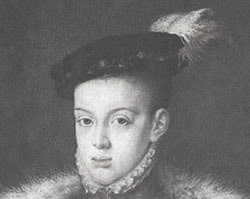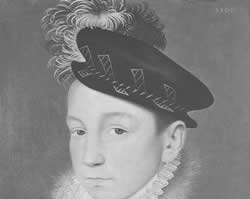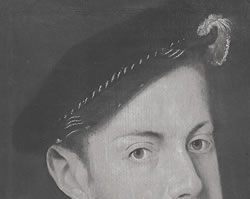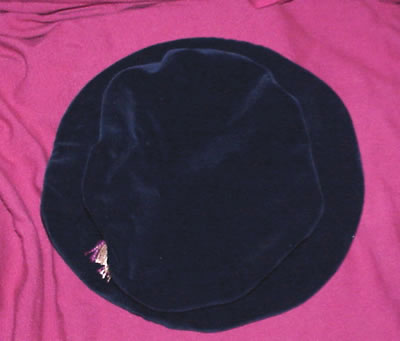The Flat Cap was the most prevalent head covering all throughout the 16th Century. This hat was worn by both men and women later in the 16th cent, but has existed from the time of Henry VII to the end of Elizabeth I's reign. This type of hat was made in many different materials depending on wealth and station. Flat caps of velvet and wool have been found and analyzed by the late Janet Arnold. She has charted out their patterns in her famous book, Patterns of Fashion: The cut and construction of clothes for men and women c1560-1620.
Materials:
The original cap that Ms. Arnold looked at was made of a silk velvet, lined in a black silk. [Arnold p.56] There was no evidence of a stiffening layer found in the brim, but that could have disintegrated over time. Another cap that was found is made of wool with a silk pile, but constructed in very much the same manner [Arnold p.93]. In period the cap could have been made of velvet, silk, linen, or wool. Wool and linen would have been most common for the lower classes, and silk and velvet seem to be the norm for the upper classes and nobility. They were embellished with embroidery, feathers, hat bands of woven materials and even jewels. The velvet bonnet that Ms. Arnold looked at from the grave of Don Grazie de' Medici is believed to have had jewels that were stolen before she found it.
I used a black cotton velvet for the crown and brim of the hat, lining the crown in a russet linen, and using felt to slightly stiffen the brim instead of buckram. This flat cap has been entirely hand sewn using a running stitch with periodic backstitches to lock it in place. The pattern came from Lady Lisette la Roux's class taught at University of Atlantia, Session #59 on Simple Head coverings for the Late Period Beginner in the Barony of Lochmere. The original pattern was drafted by Mistress Isobel Bedingfield. The trim on the crown is a fingerloop braided cord of a common style, made to match the decoration on both King Phillip's hat and King Charles IX's hat.
 |
 |
 |
| Prince Don Carlos of Austria c. 1556 Painted by Alonso Sanchez Coello |
Portrait of King Charles IX of France. |
Detail of a Portrait of the Philip II, King of Spain c. 1554 Painted by Anthonis Mor Van Dashorst |
 |
 |
| Top of hat. In the next version I think the crown needs to be a larger circle. |
Inside of flat cap. Shows russet linen lining of crown, and pleating of crown to brim. |
 |
Detail of trim on hat. Fingerloop braided with pearl cotton in red and cold. |
Pattern:

The Pattern is quite simple to construct:
- Cut three brims, one of the buckram or stiffening material and two of the fashion fabric.
- Cut two crowns, one in the fashion fabric and one in the lining.
- In the period example the crown is flat lined with the lining and then worked as one layer.
- Sew the three brims together at the outside edge, the two right sides of your fashion fabric facing each other and the stiffening on top.
- Turn the brim inside out showing the fabric only, with the stiffening hidden inside.
- Carefully pleat the crown of the hat to the inside edge of the brim.
- For finishing the insides, you could use bias tape to cover the raw edges. You could also sew the crown to the outside and stiffening layer of the brim and then hand sew the edges inside the brim lining. Lastly, you can work the crown lining separately to cover the raw edges.
- A woven or jeweled hatband with or without a feather could be used for decoration of the brim. Take your inspiration from period portraits.
Bibliography:
Arnold, Janet. Patterns of Fashion: The cut and construction of clothes for men and women c1560-1620. Macmillan. London. 1985. ISBN 0-333-38284-6
Dreher, Denise. From the Neck Up: An Illustrated Guide to Hatmaking. Madhatter Press. 1981. ISBN 0941082008
Fischer, Jennifer. Simple Headcovering for the Late Period Beginner. University of Atlantia, Session #59, Lady Lisette la Roux
How to Make a Renaissance Hat. http://costumes.org/history/100pages/RENHAT.HTM